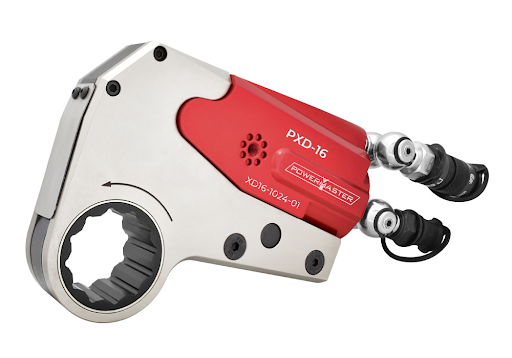In industrial environments where heavy-duty bolting is common, ensuring accuracy and safety is non-negotiable. Over-tightened or under-tightened bolts can lead to equipment failure, leaks, and costly downtime. Hydraulic torque wrenches are a solution to this problem. These tools are designed to apply exact torque consistently, even in the most demanding industries such as Oil & Gas, power generation, construction, and heavy machinery assembly. In this article, we’ll explore the components, working principle, advantages, and maintenance of hydraulic torque wrenches.
Components of Hydraulic Torque Wrenches
A hydraulic torque wrench is not a single unit but rather a system made of interconnected components. Each plays an essential role in ensuring accurate torque delivery:
1. Hydraulic Pump
The pump converts mechanical energy into hydraulic pressure. It can be operated manually, electrically, or pneumatically, depending on the application. The pump controls the amount of pressure applied, directly influencing the torque output of the wrench.
2. High-Pressure Hose
The pressurized hydraulic fluid travels from the pump to the wrench through durable, high-pressure hoses. These hoses are designed to withstand extreme conditions. They ensure consistent transmission of force without leaks or pressure drops.
3. Hydraulic Wrench
The wrench itself is the heart of the system and includes:
- Hydraulic Motor: Converts pressurized fluid into rotational energy.
- Gearbox: Multiplies the force generated by the motor, allowing the wrench to deliver very high torque levels.
- Output Drive: Usually a square or hex drive, it directly engages with the fastener.
Understanding these components highlights why hydraulic torque wrenches are considered highly dependable in industrial bolting operations; they are engineered for robustness, precision, and repeatability.
How Hydraulic Torque Wrenches Work
The working principle of a hydraulic torque wrench is straightforward yet highly effective. Here’s a step-by-step overview:
- Pressurization: The pump pressurizes hydraulic fluid and sends it through the hose to the wrench.
- Conversion to Rotational Force: The hydraulic motor inside the wrench converts this fluid pressure into mechanical energy.
- Torque Application: The gearbox amplifies the rotational energy, delivering it to the output drive that engages with the nut or bolt.
- Controlled Tightening: By controlling the pump’s pressure, operators can precisely determine the torque delivered, ensuring uniform fastening across all bolts.
This process allows hydraulic wrenches to repeatedly deliver the exact same torque value, eliminating inconsistencies caused by manual methods.
Advantages of Hydraulic Torque Wrenches
Hydraulic wrenches have become indispensable across industries for several reasons:
- Unmatched Accuracy: They deliver torque values with a high degree of precision (typically within ±3%), far exceeding manual torque tools.
- High Torque Capacity: These tools can apply torque ranging from a few hundred to several tens of thousands of Newton-meters, making them suitable for heavy-duty applications.
- Consistency and Repeatability: Every bolt tightened with a hydraulic wrench receives the same torque, ensuring uniform load distribution and joint reliability.
- Operator Safety: Compared to manual torque tools, hydraulic wrenches reduce operator fatigue and minimize the risk of injury. Their ergonomic design and controlled operation make them safer in high-stress environments.
- Versatility: With different configurations such as square drive and low-profile wrenches, they can handle bolts in both open spaces and tight, hard-to-reach locations.
Common Applications of Hydraulic Wrenches
Hydraulic torque wrenches are used in almost every industry where high-strength bolting is required. Some key applications include:
- Oil & Gas: Pipeline flanges, pressure vessels, and drilling equipment.
- Power Generation: Steam turbines, wind turbines, and hydroelectric dams.
- Construction & Infrastructure: Bridges, heavy cranes, and steel structures.
- Mining & Heavy Equipment: Earthmovers, crushers, and hauling machines.
- Shipbuilding: Propulsion systems and structural fastenings.
In all these industries, precision bolting ensures safety, efficiency, and compliance with strict regulatory standards.
Maintenance Tips for Hydraulic Torque Wrenches
Like all industrial equipment, hydraulic wrenches require proper maintenance to remain accurate and reliable. Some key tips include:
- Regular Calibration: Ensures torque accuracy and compliance with industry standards.
- Inspection of Hoses: Check for wear, cracks, or leaks to prevent accidents.
- Lubrication of Moving Parts: Keeps the gearbox and drive mechanism operating smoothly.
- Clean After Use: Prevents contamination of hydraulic systems and extends tool life.
- Storage in Dry Conditions: Protects the system from corrosion and fluid contamination.
With proper care, a hydraulic torque wrench can last for many years while maintaining its accuracy.
Conclusion
Hydraulic torque wrenches are the backbone of precision bolting in industries where accuracy and safety cannot be compromised. By delivering consistent torque values, they help prevent equipment failures, improve productivity, and extend the lifespan of critical assets.
For businesses seeking reliable and high-performance solutions, Powermaster Ltd. offers a world-class range of hydraulic torque wrenches and accessories. Built to international standards, their tools are engineered for durability, precision, and operator safety. Whether you’re in Oil & Gas, construction, or heavy engineering, Powermaster Ltd. ensures you have the right tools to achieve consistent results.
Explore Powermaster’s hydraulic solutions today and experience the difference in performance and reliability.

